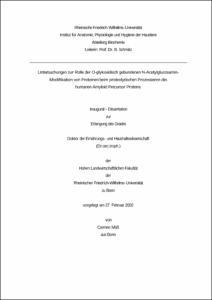Untersuchungen zur Rolle der O-glykosidisch gebundenen N-Acetylglucosamin-Modifikation von Proteinen beim proteolytischen Prozessieren des humanen Amyloid Precursor Proteins

Untersuchungen zur Rolle der O-glykosidisch gebundenen N-Acetylglucosamin-Modifikation von Proteinen beim proteolytischen Prozessieren des humanen Amyloid Precursor Proteins

| dc.contributor.advisor | Schmitz, Brigitte | |
| dc.contributor.author | Mäß, Carmen | |
| dc.date.accessioned | 2020-04-05T15:09:41Z | |
| dc.date.available | 2020-04-05T15:09:41Z | |
| dc.date.issued | 2002 | |
| dc.identifier.uri | https://hdl.handle.net/20.500.11811/1764 | |
| dc.description.abstract | Das Amyloid Precursor Protein (APP) spielt eine zentrale Rolle bei der Pathogenese der Alzheimer Demenz (AD). APP wird durch die sog. α-, β- und γ-Sekretase zu verschiedenen proteolytischen Fragmenten gespalten. Diese Prozessierung von APP wird u.a. durch verschiedene Signalkaskaden reguliert. O-glykosidisch an Serin- oder Threonin-Reste gebundenes N-Acetylglucosamin (O-GlcNAc) ist eine ubiquitäre intrazelluläre Kohlenhydratmodifikation von Proteinen. O-GlcNAc scheint u.a. die Assoziation von Proteinen zu beeinflussen und ein zur Phosphorylierung alternatives Signaltransduktionssystem darzustellen. Basierend auf früheren Untersuchungen, in denen gezeigt worden war, dass (a) APP O-GlcNAc-modifiziert ist und (b) in humanen Hirnregionen von AD-Patienten die O-GlcNAc-Expression signifikant erhöht ist, sollte in der vorliegenden Arbeit die Bedeutung der O-GlcNAc-Modifikation von Proteinen für das proteolytische Prozessieren des humanen APP695 untersucht werden. Dazu wurden Experimente an stabil mit der cDNA des humanen APP695 transfizierten N2a-Zellen durchgeführt. Im Vergleich zu nicht-transfizierten, parentalen N2a-Zellen wiesen die das humane APP695 exprimierenden N2a-Zellen längere Neuriten sowie eine gesteigerte Zelladhäsion auf. Die Beobachtung steht im Einklang mit Untersuchungen an anderen APP-exprimierenden Zellen. Es konnte gezeigt werden, dass das von den N2a-Zellen exprimierte humane APP695 O-GlcNAc-modifiziert ist. Die unreife Form des Proteins wies eine stärkere O-GlcNAcylierung auf als die reife Form. Dies traf sowohl für den Wildtyp als auch die schwedische Mutante des humanen APP695 zu. Es wurde kein signifikanter Einfluss einer erhöhten O-GlcNAc-Modifikation von Proteinen auf die Sekretion des humanen APPs bzw. APPsα beobachtet. Im Gegensatz dazu konnte eine signifikant reduzierte Sekretion des humanen Aβx-40 verzeichnet werden, was jedoch einer Absicherung durch weitere Versuche bedarf. Dieses vorläufige Ergebnis könnte auf eine Beteiligung der O-GlcNAcylierung an der Regulation der Prozessierung von APP hindeuten. Des weiteren führte die gesteigerte O-GlcNAc-Modifikation von Proteinen zu einer verstärkten Expression des humanen APP695 in Neuriten. Daraus lässt sich schließen, dass die O-GlcNAcylierung von APP selbst oder aber von anderen Proteinen möglicherweise eine wichtige Rolle beim axonalen Transport von APP spielt. | en |
| dc.description.abstract | Investigations into the role of the O-glycosidically linked N-acetylglucosamine modification of proteins in the processing of the human amyloid precursor protein The Amyloid precursor protein (APP) plays a central role in the pathogenesis of Alzheimer’s disease (AD). APP is cleaved by so-called α-, β- and γ-secretase leading to the generation of several proteolytic fragments. This processing of APP is regulated by a variety of different signaling pathways. N-acetylglucosamine O-glycosidically linked to serine or threonine residues (O-GlcNAc) is a ubiquitous intracellular carbohydrate modification of proteins. O-GlcNAc may be involved in the multimerization of proteins and may function as an alternative signal transduction pathway to phosphorylation. Based on former investigations demonstrating that (a) APP is O-GlcNAc-modified and (b) in human brain areas of AD patients the O-GlcNAc expression of proteins is significantly upregulated, the aim of the present study was to elucidate the role of the O-GlcNAc modification of proteins for the proteolytic processing of human APP695. Experiments were performed on N2a cells stably transfected with the cDNA of human APP695. Human APP695 expressing N2a cells exhibited longer neurites and an increased cell adhesion compared to non-transfected, parental N2a cells. These observations are in agreement with former investigations on other APP-expressing cell types. It was shown that human APP695 expressed by N2a cells is O-GlcNAc-modified. The immature protein was more heavily O-GlcNAcylated than the mature form. This observation was shown to be true for the wild type as well as the Swedish mutant of human APP695. Increased O-GlcNAc-levels of proteins did not have any significant influence on the secretion of human APPs and APPsα respectively. On the contrary, it resulted in a significant reduction of the secreted human Aβx-40; this, however, needs to be confirmed in additional experiments. This preliminary result may hint at the involvement of O-GlcNAcylation in the regulation of the proteolytic processing of APP. Furthermore, it was shown that the increased O-GlcNAc-levels of proteins lead to an enhanced expression of the human APP695 in neurites. As a result, O-GlcNAcylation of APP itself or of other proteins may play a major role for the axonal transport of APP. | en |
| dc.language.iso | deu | |
| dc.rights | In Copyright | |
| dc.rights.uri | http://rightsstatements.org/vocab/InC/1.0/ | |
| dc.subject | O-GlcNAc | |
| dc.subject | APP | |
| dc.subject | Processing | |
| dc.subject.ddc | 540 Chemie | |
| dc.subject.ddc | 570 Biowissenschaften, Biologie | |
| dc.title | Untersuchungen zur Rolle der O-glykosidisch gebundenen N-Acetylglucosamin-Modifikation von Proteinen beim proteolytischen Prozessieren des humanen Amyloid Precursor Proteins | |
| dc.type | Dissertation oder Habilitation | |
| dc.publisher.name | Universitäts- und Landesbibliothek Bonn | |
| dc.publisher.location | Bonn | |
| dc.rights.accessRights | openAccess | |
| dc.identifier.urn | https://nbn-resolving.org/urn:nbn:de:hbz:5n-02026 | |
| ulbbn.pubtype | Erstveröffentlichung | |
| ulbbnediss.affiliation.name | Rheinische Friedrich-Wilhelms-Universität Bonn | |
| ulbbnediss.affiliation.location | Bonn | |
| ulbbnediss.thesis.level | Dissertation | |
| ulbbnediss.dissID | 202 | |
| ulbbnediss.date.accepted | 11.06.2002 | |
| ulbbnediss.fakultaet | Landwirtschaftliche Fakultät | |
| dc.contributor.coReferee | Wingender, Ruth |
Files in this item
This item appears in the following Collection(s)
-
E-Dissertationen (1120)




